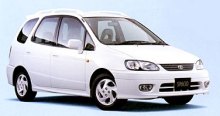 It
is generally regarded that new cars should be better than their
predecessors,
otherwise, why not remain unchanged? The current Toyota Corolla is on
the
contrary. Visually, it looks a lot more conservative than its
predecessor,
which was the most elegant-looking cars in this segment a few years
ago.
For the new Corolla, I can still remember my first impressive about it
in 1995: I can't even believe my eyes, it looked more like an older car
than its predecessor! Well, conservative is not wrong (it depends on
your
taste and age), but this car looks cheap and likely to be made with
degraded
quality, something every other manufacturers had successfully avoided
during
cost reduction. It hurt the Corolla's traditional healthy image very
bad. It
is generally regarded that new cars should be better than their
predecessors,
otherwise, why not remain unchanged? The current Toyota Corolla is on
the
contrary. Visually, it looks a lot more conservative than its
predecessor,
which was the most elegant-looking cars in this segment a few years
ago.
For the new Corolla, I can still remember my first impressive about it
in 1995: I can't even believe my eyes, it looked more like an older car
than its predecessor! Well, conservative is not wrong (it depends on
your
taste and age), but this car looks cheap and likely to be made with
degraded
quality, something every other manufacturers had successfully avoided
during
cost reduction. It hurt the Corolla's traditional healthy image very
bad.
Luckily, drive it, one can found there is still some improvement - a little bit quieter, engine is more torquer at low rev, plus some minor changes in the cabin. From 2000, VVT-i technology has been added to further improve power and torque. Now the 1.4-litre four is good for 97 hp, 1.6-litre is 110 hp while the US-only 1.8 produces 125 hp, all are well above class average, if not Honda-chasing. In additional to the lightweight, Corolla is one of the fastest cars in the C segment.
Lively engines aside, Toyota has been gradually improving the chassis of Corolla. Compare with the '95 model, today's Corolla (especially the European version) handles better, thanks to the strengthening of chassis. Although steering is still too light and lack of feel, it controls the body precisely. The setting of the all strut suspensions is bias towards comfort but without introducing too much body roll. As a result, the Corolla is refined and comfortable enough to please women drivers while without letting men down. Of course, for real driving fun, Corolla is still not a natural choice. Today, the biggest disadvantage of Corolla is perhaps cabin space for rear passengers. Basically, its wheelbase is very short compare with rivals - 150 mm shorter than Ford Focus and Honda Civic - so that rear legroom is very limited. Not only this is the crampest cabin in class, it is also the dullest. There's no much style in the cabin - grey dash, grey seats, cheap-looking plastics ... Then, why are there so many people buy the Corolla? what made it the no. 1 best seller in history, with 23 million people purchased 8 generations of Corolla? From the beginning, the Corolla's strongest selling points have been reliability, economical and good after-sale service. This one remains unchanged in this respect. This Corolla was
developed
during the economic recession in Japan several years ago. Its major
objective
was to reduce production cost as well as development cost, so the basic
structure and mechanical parts are carried over with little
modifications
- and most modifications are made for the purpose of cost reduction. It
seems that the company is too sensitive to the recession. It preserved
profit but lost two precious things - image and competitiveness in
Western
market. Now the recession has gone, let's hope its successor to be
radical. |
| The above report was last updated on 22 Apr 2000. All Rights Reserved. |
 <
European Corolla
<
European Corolla 
